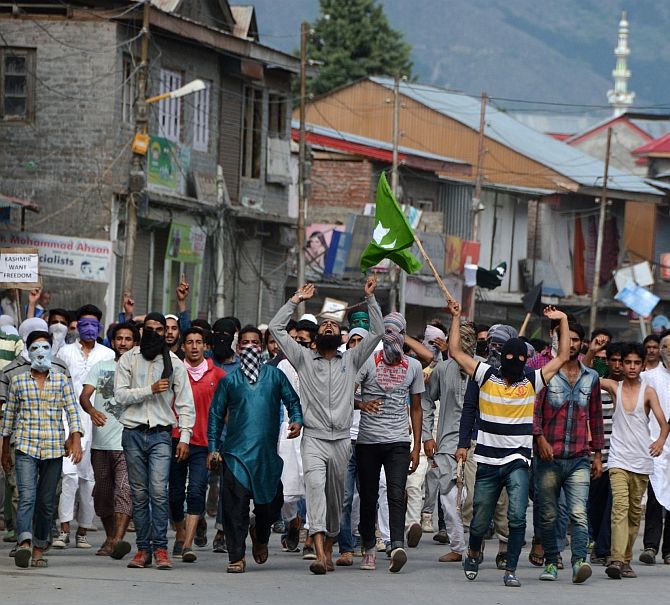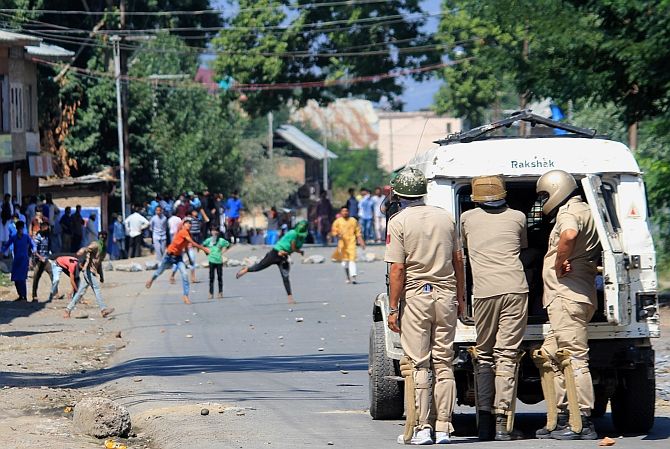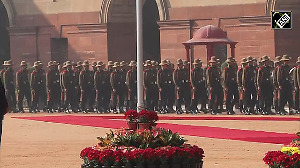
'As long as Pakistan exists, the situation will not stabilise and violence is bound to erupt from time to time.'
'Though not a final solution, a step that could help localise the abscess -- trifurcate Jammu and Kashmir state into three parts: Jammu, Ladakh and the valley, suggests Claude Arpi..
On August 15, in a speech from the Red Fort, Prime Minister Narendra Modi referred to Pakistan's human rights abuses in Balochistan as well as Pakistan occupied Kashmir.
Modi hinted that if Pakistan continues to instigate demonstrations and strikes in the Kashmir valley, India will be compelled to expose Islamabad elsewhere.
Let us be clear, as long as Pakistan exists, the situation will not stabilise and violence is bound to erupt from time to time.
In order to find a solution to the Kashmir issue, an all party delegation has just paid a two-day visit to Jammu and Kashmir.
Of course, Ladakh was not on the programme.
Addressing the media in Srinagar, Home Minister Rajnath Singh remarked that all parties have agreed that the situation in Jammu and Kashmir should improve at the earliest. He also noted that the delegation’s talks with various sections in J&K have been fruitful.
The Press Information Bureau says that on the second day the delegation went to Jammu where 'the delegation met over 200 persons in about 18 different delegations from various sections of society.'
Various sections minus Ladakhis!
The neglect of Ladakh is not new.
Though not a final solution, a step that could help localise the abscess -- trifurcate Jammu and Kashmir state into three parts: Jammu, Ladakh and the valley.
It has been a long standing demand of the people of Ladakh (and Jammu as well) who do not want to have anything to do with the anti-India movement in the valley.
A resolution passed by the All Religious Joint Action Committee of Ladakh goes a long way in this direction.
ARJAC leaders -- Tsewang Thinles, president, Ladakh Buddhist Association, Ashraf Ali Barcha, president, Anjuman Imamia, and Sheikh Saif-ud-Din, president, Anjuman Moin-ul-Islam -- demanded at a press conference Union Territory status for Ladakh. They remarked that since Independence, the mountainous region has always kept a special strong bond with the Union of India.
In a memorandum to the prime minister, the ARJAC explained that Ladakh was once an independent Himalayan kingdom: 'The political history of Ladakh dates back to 930 AD when several small, sovereign principalities outlying the Western Himalayas were integrated and given a unified polity by Lha-Chen-Palgigon.'
'Ladakh as an independent kingdom gained political status during the 15th-16th century when the Namgyal dynasty came into power,' the memonrandum added.
This lasted until 1842 when General Zorawar Singh integrated Ladakh into the Dogra empire. In October 1947, Ladakh acceded to India after Maharaj Hari Singh signed the Instrument of Accession for his state.
Ladakh, the ARJAC further pointed out, has been linked to the Dogras (and Kashmir) for hardly 105 years: 'Ladakh is fundamentally different from Kashmir in all respects -- culturally, ethnically and linguistically. Over the years the successive governments of the state have adopted a policy of discrimination and subversion towards the region with the sole objective of stifling its people and marginalising its historical, religious and cultural identity.'

In modern times,' the ARJAC noted with some bitterness, 'when the whole subcontinent has passed through the process of decolonisation to enjoy the fruits of national Independence, we, the people of Ladakh, and our land still continue to suffer under the old concept of colonial administrative structure, which suited the imperial interests and feudal rulers under the name of the pseudo-state of Jammu & Kashmir.'
'Nationalism remained a dominant ideological creed and became a rallying force among the Ladakhis to fight back the Pakistanis and the Chinese who made frequent bids of conquer our land in 1948, 1962, 1965, 1971 and 1999 wars,' the ARJAC affirmed. 'The jawans of Ladakh Scouts played an exemplary role in decisively foiling the enemy's misadventures.'
'Our humble submission is that we are neither the problem nor part of any problem involving the state. Rather we are the solution. We firmly believe that all of us live only if India lives. Our commitment to patriotism is firm and unequivocal. Our people and soldiers have never hesitated to make supreme sacrifices in the discharge of their duties towards the country. We shall never fail the nation.'
The bifurcation (or trifurcation) would have other advantages not mentioned in the memorandum.
Today the Ladakh region has two districts, Leh and Kargil and two Autonomous Hill Development Councils, Ladakh and Kargil.
Though Ladakh is India's largest district, with 'disputed' borders and two belligerent neighbours, it is administered by a junior officer.
The present District Commissioner Prasanna Ramaswamy is a young IAS officer from the 2010 batch. Without doubting his personal competence, such a border district with large numbers of army and Indo-Tibetan Border Police personnel posted in the area makes it one of the most sensitive districts of the country.
Further, can only one officer visit the 19 blocks of Ladakh, some of the extremely remote? He can't.
Ladakh needs a special status; a joint-secretary rank officer or above should be posted in the district. The Indian Army's 14 Corps Commander responsible for Ladakh's defence is headed by an officer of lieutenant general rank, with nearly 40 years of experience in the army. He deals with someone (the DC) who would be ranked a captain, or a major at the most, in the army.
Incidentally, the DC is also the chief executive officer of the LAHDC, which makes the situation even more ridiculous.
The granting of Union Territory status would solve many of these anomalies: A lieutenant governor representing the Centre would sit in Leh (or Kargil) and a chief secretary would head the administration.
Further, the elected MLAs and ministers would not depend on the mood of Srinagar to develop the Union Territory.
Last but not least, it will probably force China to clarify its position vis-a-vis Ladakh.
Beijing has always been ambiguous on Kashmir and Ladakh.
In July, Beijing called for a 'proper settlement of Kashmir clashes.' Under the pretence of neutrality, China's position on Kashmir has indeed conveniently remained extremely hazy.
'Nothing could be further from the truth than this duplicitous and outrageous statement (about neutrality),' defence analyst Monika Chansoria recently pointed out. 'In fact, Beijing has shifted its position on Kashmir, gradually, yet firmly, with each passing decade. Recall China's response during the 1999 Kargil conflict with its commitment to a policy of neutrality, which compelled the Nawaz Sharif government, who was already under immense international pressure, to look for an honourable retreat from Kargil.'

Remember the issue of stapled Chinese visas for J&K's state subjects?
Another issue is Beijing's refusal to reopen the Demchok-Tashigong road to Kailash-Manasarovar. It is the fastest and easiest route for pilgrims wanting to visit the holy mountain. Beijing does not want the route to be reopened, because it would not be 'neutral' anymore and would have to recognise the fact that Ladakh is part of India (by setting up a custom house at the border, for example).
Already back in 1954, when India and China were negotiating the Panchsheel Agreement, China adamantly refused to acknowledge, let alone reopen the Demchok route, simply because it considered and probably considers Ladakh 'disputed territory.'
The reopening of the ancient pilgrim route would be a great confidence building measure between India and China, but perhaps Beijing is not ready to give up the 'disputed territory' label for Ladakh.
Making Ladakh a Union Territory would (peacefully) kill many birds with one stone. It would help localise the so-called Kashmir issue in the valley; it would provide a better administration to the mountainous region, streamline the security of the area and force China to drop its 'neutrality' stance.
But where is the political will?
ALSO READ










